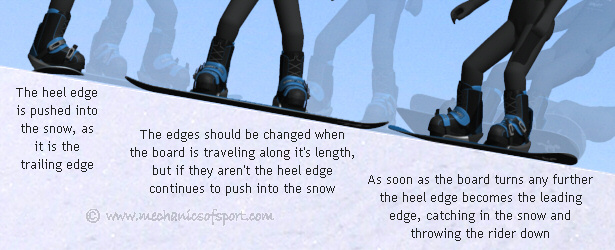Ways an Edge Can Catch
There are 3 different ways a single variable can change to create an edge catch, although the variables can also change simultaneously. It is good to know about the different ways as being aware of them makes it easier to avoid catching edges. Each of the ways is detailed below.
The Angle of the Slope Changes
If a slope flattens off but the angle of the snowboard is not changed, this will bring the leading edge closer and closer to the snow until it catches. This happens through unobservance, as the rider does not need to move to create the edge catch. It is the rider's lack of observance to what their environment is doing that causes the edge to catch. Whereas if the rider notices the gradient changing they can react and change the angle of the snowboard to avoid an edge catch.
The Angle of the Snowboard Changes
If the angle of the snowboard changes, but the slope is not steep enough to allow this angle, the edge will catch. This generally happens when a snowboarder tries to increase their speed without turning the snowboard forwards enough. The edge catch happens through rider error, as the rider makes a change that their environment does not allow, and it is the riders movement that causes the edge to catch.
The Direction of the Snowboard Changes
If like in a turn situation, the direction the snowboard changes so that the leading and trailing edges swap, but the edge that is pushing into the snow isn't changed, the trailing edge that is pushing into the snow will become the leading edge and catch. This happens through a mixture of rider error and bad observance, as changing the direction of the snowboard is what makes the edge catch possible, and unobservance to change the edge at the right time is what allows the edge catch to happen. Beginners can find changing the edge at the right time a bit difficult, it does take some practice to be able to know exactly when to change the edge.

The board direction edge catch does not always happen quite how it is shown above. As the trailing edge turns into the leading edge the sideways velocity of the edge is very small to start with, and sometimes instead of the edge catching and stopping the snowboard, the edge will catch and use its curved shape to carve the snowboard back around so that it becomes the trailing edge again, which cannot catch. You might think that this means you end up recovering from the mistake, but unfortunately when this happens it normally sends the rider off balance so that they lose the pressure on the trailing edge and push on the leading edge, the leading edge then catches and sends the rider down. If you are quick to react it is possible to recover from this situation, but generally if the edges aren't changed at roughly the right time you will get sent snowwards by the other edge catching if the first one doesn't manage to do the job.
Another mistake that can be made while turning is when the snowboarder tries to change the edge on the snowboard too early. This is actually an edge catch because of the change in snowboard angle although in this case it happens in a turning situation.
On to the Types of Edge Catch section.